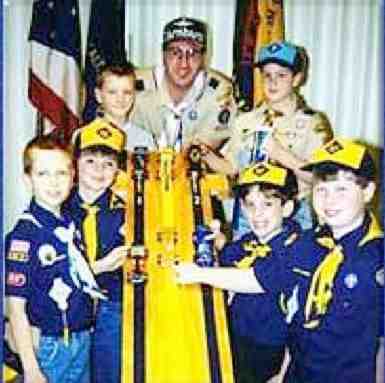
Figure 1.--Cubs are pictured here in the 1990s participating in the Pinewood Derby Nptice the Weblo Cub in the background. |

|
The Pinewood Derby is one of the most popular American Cub activities. The program was introduced in the 1950s. Simce that time, more than 10 million have participated in the Official Cub Scout Pinewood Derby program. The Pinewood Derby was first run by Manhattan Beach, California Cub Scout Pack 280C (1953). It proved so popular that the BSA decided to promote it nationally. THE BSA published plans for the early Derby cars in Boys' Life (October 1954). The idea was an immediate success. Cub packs throughout the country enthusiastically adopted the Grand Prix of Scouting. The idea comines interests in cars, crafts, and cometition. Cub Scouts from the 2nd-5th grades work on their pinewood blocks, fashioning cars
and adding wheels. The work is done with adult assistance--normlly their fathers. The Pinewood Derby cars have specified weight, length and design parameters set by the BSA. It is important that the local Packs can compete on an equal level at district competitions. And then on the appointed date each Pack meets for the great showdown--the Pinewood Derby race. Cubbers report a NASCAR or Indinpolis 500 (Indy) atmosphere pervde the event. The race is conducted on along, graduating descent track. Here the drivers" dual with their Pinewood cars. After a formal registration, only the "drivers" (Cubs) can touch the cars. The cars must be returned to the pit after each race, with no modifications permitted.
The Pinewood Derby is one of the most popular American Cub activities. The program was introduced in the 1950s. Simce that time, more than 10 million have participated in the Official Cub Scout Pinewood Derby program. One of the key gaols of the Boy Scouts is to provide boys with a strong male role model. Cub Scouts in particular focus on father son activities such as picnics, field trips, and fishing. The most popular, and formalized, father son activitie during the 1960s was the Pinewood Derby.
The Pinewood Derby was first run by Manhattan Beach, California Cub Scout Pack 280C (1953). It proved so popular that the BSA decided to promote it nationally. THE BSA published plans for the early Derby cars in Boys' Life (October 1954). The idea was an immediate success. Cub packs throughout the country enthusiastically adopted the Grand Prix of Scouting.
The idea comines interests in cars, crafts, and cometition.
Cub Scouts from the 2nd-5th grades work on their pinewood blocks, fashioning cars
and adding wheels. The work is done with adult assistance--normlly their fathers. The Pinewood Derby cars have specified weight, length and design parameters set by the BSA. It is important that the local Packs can compete on an equal level at district competitions. The car kits are supplied by the BSA. The kits are designed and built by the boy and an adult partner. Although many modifications can be made, the block of pine wood, wheels and axles (nails) from the kit must be used. The Cub and his Dad put the car together. Standard wooden racer kits were used to create a father son project that could be shown off to the entire pack at a special meeting.
There was a great build-up followed by the big night. Cubs on the appointed date each Pack meets for the great showdown--the Pinewood Derby race. Cubbers report a NASCAR or Indinpolis 500 (Indy) atmosphere pervde the event. The race is conducted on along, graduating descent track. Here the drivers" dual with their Pinewood cars. After a formal registration, only the "drivers" (Cubs) can touch the cars. The cars must be returned to the pit after each race, with no modifications permitted. A typical Cub pack might have 60 boys eligible to participate. In a active pack 30 boys might bring their cars to race. Tigers (first grade boys) compete separately. The
remainder of the Pack consists of boys in the 2nd through 5th grades. "Drivers" are the boys themselves. They are the only person that may handle the car after inspection at the check-in. The drivers chose a "best design" winner among themselves. At one 1999 event, many cars had different shapes and colors, even a Sheriff's cruiser complete with working lights and siren! But the favorite was a Le Mans style formula car. The racing can be fast and exciting. Each Cub's car is entered into the double elimination, best of three heats, tournament. Rounds might have exciting series where two cars were judged to be equally fast. It is not unknown for four dead heats to determine a round winner. The big event was a series of elimination races on wooden track leading to a grand winner. Iy was not just the fastest racer that won. There were prizes for the best cars in categories like funniest, scariest, best paint job, etc. In keeping with the spirit of Cub Scouting every boy got a ribbon for something.A smaller track is used for the younger Tiger Cubs.
Navigate the Historic Boys' Uniform Chronology Pages:
[Return to the Main chronologies page]
[The 1900s]
[The 1910s]
[The 1920s]
[The 1930s]
[The 1940s]
[The 1950s]
[The 1960s]
[The 1970s]
[The 1980s]
[The 1990s]
[The 2000s]
Navigate the Historic Boys' Uniform Web Site:
[Activities]
[Biographies]
[Chronologies]
[Countries]
[Essays]
[Garments]
[Organizations]
[Religion]
[Other]
[Introduction]
[Bibliographies]
[Contributions]
[FAQs]
[Questions]
[Unknown images]
[Boys' Uniform Home]
Navigate the Historic Boys' Uniform Web organizatiion pages:
[Return to the Msin Cub activity page]
[Return to the Main U.S. Cub page]
[Return to the National Scout page]
[Boys' Brigade]
[Camp Fire]
[Hitler Youth]
[National]
[Pioneers]
[Royal Rangers]
[Scout]
